In part 1 of my discussion of Agrippa’s fencing system, I focused on the positions that are described in the manual. Importantly I extrapolated a set of “degrees-of-freedom” based on the ways in which the various positions differed from each other. In this posting, I hope to demonstrate the importance of those degrees-of-freedom by describing how they show us the movements that are possible within Agrippa’s fencing system.
I created a handy chart that can be found here.
Previously I described 5 degrees-of-freedom, namely guard, stance, sword position, alignment, and front foot. Using these degrees-of-freedom, I showed that it is possible to describe all 14 different positions that are shown in Agrippa’s manual that are concerned with the single sword. However, it is also the case that these degrees-of-freedom describe the necessary motions needed in order to transition between these positions and ultimately, the motions that are possible within the system. Let us therefore consider them each in turn:
Guard:
As noted before, Agrippa describes 4 guards named prima, seconda, terza, and quarta. Within Agrippa’s fencing system, the guards are solely concerned with the rotation of the sword, with prima describing a position where the true edge is pointed upwards, second a position with the true edge rotated towards the outside, and so on. Therefore, the movement described by this degree-of-freedom is primarily concerned with a rotation of the arm. The illustrations suggest that this rotation occurs somewhat independently from the elbow and that it involves the rotation of both the sword and hand, which means that this rotation is primarily achieved by a rotation of the forearm via the radioulnar joint. However the illustrations do suggest that some degree of elbow rotation is present between seconda and terza and likewise that some degree of shoulder rotation is present between prima and seconda.
It is worth noting here that from any given guard, it is possible to transition to at most 2 other guards. For instance, from terza it is only possible to transition to quarta or seconda. A transition from terza to prima would require two transitions, one from terza to seconda and another from seconda to prima. Obviously it is therefore only possible to transition from prima to seconda and from quarta to terza. I have found this referenced in several fencing manuals, however Agrippa does not seem to make note of it, suggesting that he either found it to be self-evident or found little practical use for such distinctions. For our purposes, such a distinction helps us to keep our framework simple and serves to demonstrate that transitions between the positions shown in Agrippa often require more than one motion, and often require movement around more than one degree-of-freedom. As a martial artist, this approach also serves another useful role, and that is to point out that in most cases, our choices of motion are typically constrained to 1-2 options along each degree-of-freedom.
Stance:
Agrippa shows us two different stances, wide and narrow. It should be obvious therefore that we will need to be able to transition between these states either by expanding a narrow guard into a wide one or by narrowing a wide guard into a narrow one. Furthermore, it is clearly possible to perform these transitions in two ways by either moving the front or back foot. This then gives us 4 possibilities. We can widen a narrow stance by stepping forward with the front foot or by stepping backward with the back foot and likewise we can narrow a wide stance by stepping backward with the front foot or by stepping forward with the back foot.
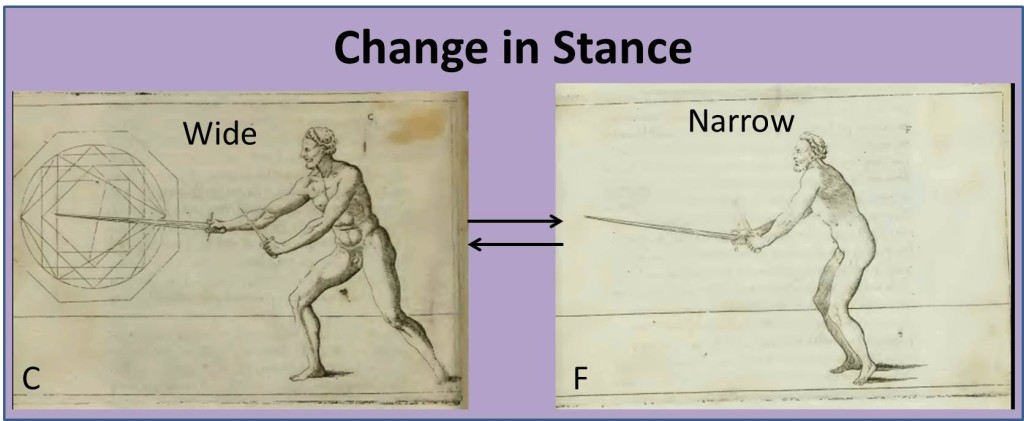
Changes in stance seem to form the basis of some of the footwork seen in Agrippa. For instance, several of the plays seem to begin with a transition from F to C to F, that is, narrow to wide to narrow while moving forward. In such a situation we would expect then that by widening the stance from F to C by moving the front foot forward and then narrowing the stance from C to F by moving the back foot forward, we can achieve something similar to the modern fencing advance. It is however important to be careful in how we interpret and describe footwork, however, as Agrippa does not directly address how to move. And, with the exception of the use of the term “traverse step,” he makes no direct references to footwork as we often modernly conceptualize it.
Sword Position (Extension):
Agrippa seems to show us three separate levels of extension that exist in at least some guards. Transition between these positions, which I have termed extended, neutral, and retracted can be carried out primarily by movement of the shoulder, elbow, and wrist. In the extended position, you will note that the arm is held straight without a bend at the elbow such that the arm and sword both point at the opponent. In the neutral position, the sword is held pointing directly towards the opponent but the arm is held slightly off-line, forming a slight angle. There also seems to be a slight bend in the elbow in the neutral position. In the retracted position the arm is held perpendicular to the opponent while the sword is held pointing towards the opponent. In all cases, the wrist is flexed in order to keep the sword pointed towards the opponent. For example, positions H, B, and E show these three different sword positions in seconda as shown below. 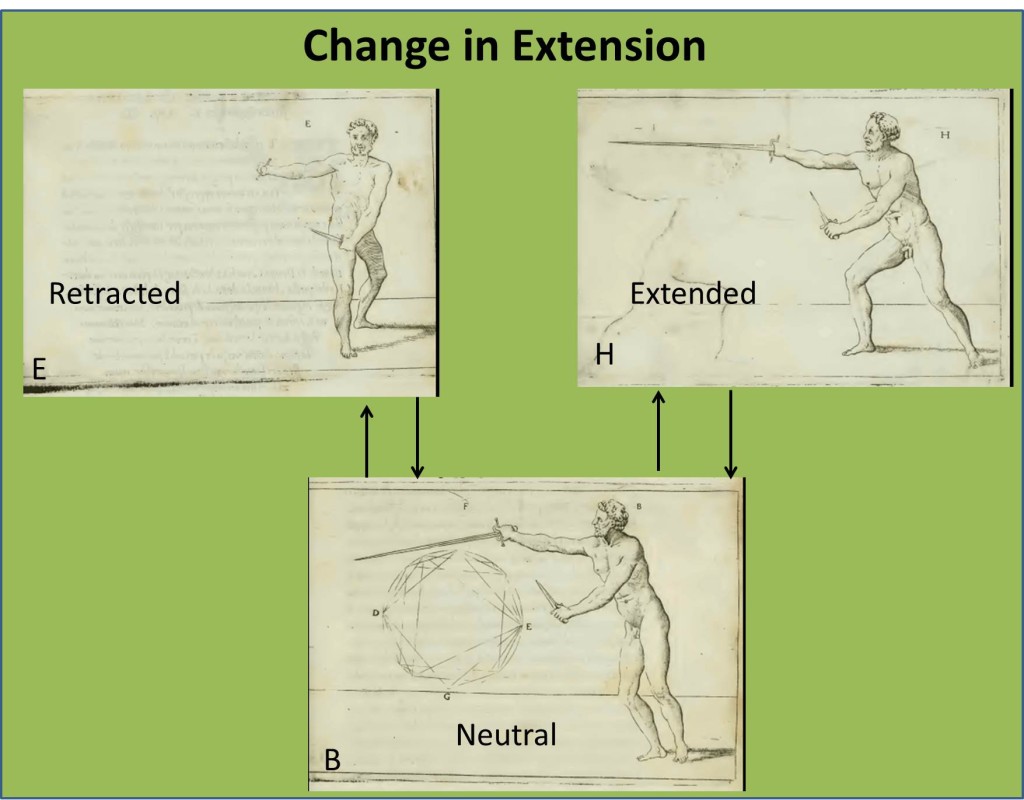
Movement from neutral to retracted position requires us to move our arm from the shoulder to a position that is perpendicular to our opponent, either out to the side such as in E, downward such as in L, or upwards as in N. Movement from neutral to extended position also requires that we extend our elbow and move our arm from the shoulder, however we instead move our arm towards our opponent as is shown in H, or I. Movement from retracted to extended position can be similarly accomplished, however you will pass through the neutral position in order to accomplish this.
Alignment (Voids):
After several weeks of consideration, I think that it would be most appropriate to describe this degree-of-freedom as the rotation around the vita. Vita translates to body, however conceptually it is a notion that is strongly tied not only to the movements present in the system, but also the aesthetic and scientific knowledge of the renaissance that underlie Agrippa’s fencing system. I previously defined this degree-of-freedom as relating to an off-line step which seems to be present in G, P, and K, but which is also described occasionally while striking the opponent in H and I. These positions are most similar to voids and off-line lunges in other fencing systems, which are situations where rotation of the body, not simply stepping off-line are necessary for success. Furthermore, some experimentation has convinced me that it is relatively easy to use a rotation of the body to drive an off-line step, but that it is relatively difficult to do the reverse. Based on this, therefore, the principle motion that defines this degree-of-freedom is a rotation of the body at the waist that may be accompanied by an off-line step.
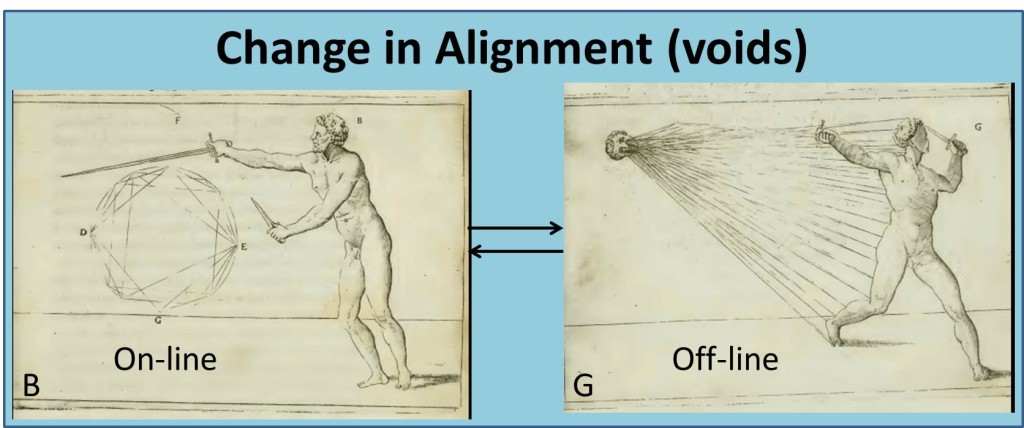
This change in understanding may also clarify the discussion of how these positions interact with stance from the previous post. Notably G, P, and K are advised to follow from wide stance, which makes an off-line step difficult (presumably this would widen a wide stance) whereas a simple rotation at the waist can be carried out without widening the (already wide) stance. If we carry this logic forward we might then expect that our response to an attack while in narrow measure is instead to perform a transition to an off-line H or I by extending the sword, rotating the vita, and widening our stance (either forward similar to what we might expect a “lunge” to look like or backwards similar to what we might call a “stop thrust”. But again, these do not seem to be discrete concepts in Agrippa). I intend to explore this further in a future post concerning the defense.
Front Foot:
Transitions between right-foot-forward and left-foot-forward positions is accomplished using what Agrippa calls a traverse step. This action is likely similar to the passing step that is incorporated in other fencing systems and simply involves either stepping forward with the back foot such that it is placed in front or by stepping backwards with the front foot such that it is placed in back. It is important to note that in the left-foot-forwards guards, we still see that weight is held over the front (left) foot, suggesting that it is important to shift body weight between the legs while performing these actions. The precise mechanics will likely be part of a future post, however it is worth noting that it is far easier to move the back foot forward than it is to move the front foot backwards due to the placement of weight on the front foot.

Transitions between Positions:
One thing that quickly becomes apparent is that transitions between the positions shown by Agrippa may involve more than one movement. Even a transition between the basic terza and seconda (C and B) requires us to change both our guard and our stance. We can therefore think of the transitions shown above as primary movements, meaning that they require a single movement and motions such as our transition from C to B shown below as secondary movements, meaning that they require two movements. Likewise, transitions that require 3 movements would be called tertiary movements and so on.
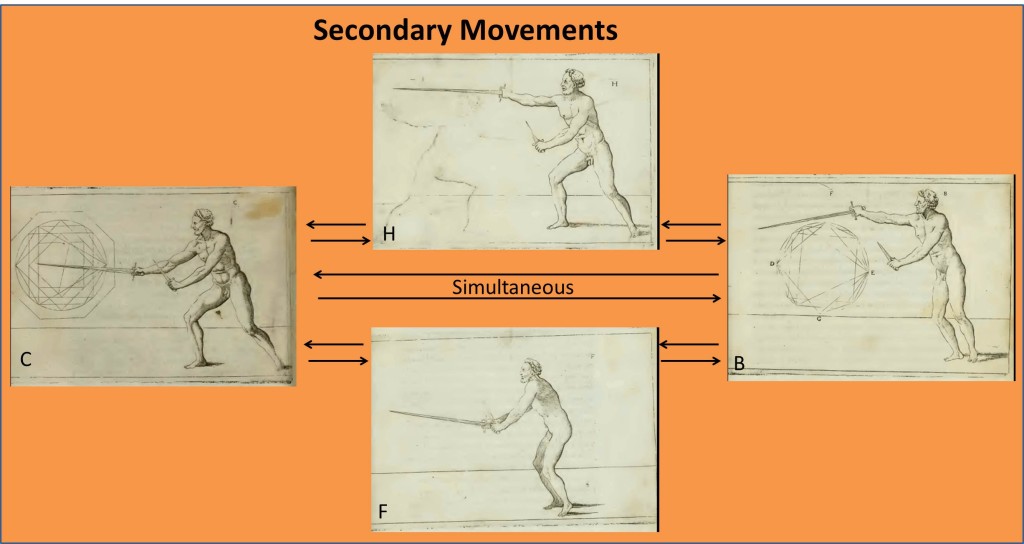
Multi-step transitions add a significant degree of complication, as we must consider not only which actions must be performed but also the order in which they are performed. That being said, it is certainly possible to carry out such actions simultaneously, however such an approach significantly increases the number of movements a fencer must become proficient at performing and greatly increases the number of options a fencer has in any given position (which I would argue is a bad thing). The other possibility is that the motions are carried out sequentially either following some rule (such as arm first, then body, then legs) or by following a path formed from the positions that we know exist in the system. Ultimately this provides us with 3 different ways of performing our transition from C to B, namely to change guard and stance simultaneously, to change guard then stance, or to change stance then guard. You will notice that the last of these can be represented as a transition from C to F to B. You might also be tempted to consider the second option to be the same as a transition from C to H to B, however the framework we have created would suggest that this would also require a change in sword extension (from neutral to extended). We might also simply expect that Agrippa allows for transitions through positions that aren’t explicitly shown, meaning that the reader should be able to understand why certain positions are unsafe and avoid those while still placing themselves in positions that he hasn’t explicitly listed. In which case, a position that is similar to H, but with the sword held with neutral extension may be inferred to exist.
So, which way is correct and what does that tell us about how to interpret the system? Let me be the first to state that I don’t know. From a biomechanics standpoint, moving more than one body part at a time creates weakness during the motion and also creates motion along curved rather than linear paths, which suggests to me that simultaneous movement is problematic. It also greatly complicates things as mentioned above. Other fencing manuals make explicit mention of moving the arm first, however Agrippa provides no such admonition. If we follow their approach, that requires that we end up in a transitional position that may not be shown by Agrippa. If we interpret H to be inclusive of this transitional position, then we must conclude that the sword position degree of freedom either does not exist or should at least be less strictly applied. The final option requires that we move our body before our hand, but allows us to follow a path of motion that clearly fits within what is shown in the manual. Notably we aren’t actually intending to land a blow with this transition (since we are ending with a neutral sword position), so moving our body first may not be a problem. Furthermore, this type of motion may form an important aspect of Agrippa’s system for controlling line (a topic that isn’t explicitly discussed) and/or maintaining opposition. Deeper reading of the manual may help us to answer this question, but if not, we will need to do so empirically.
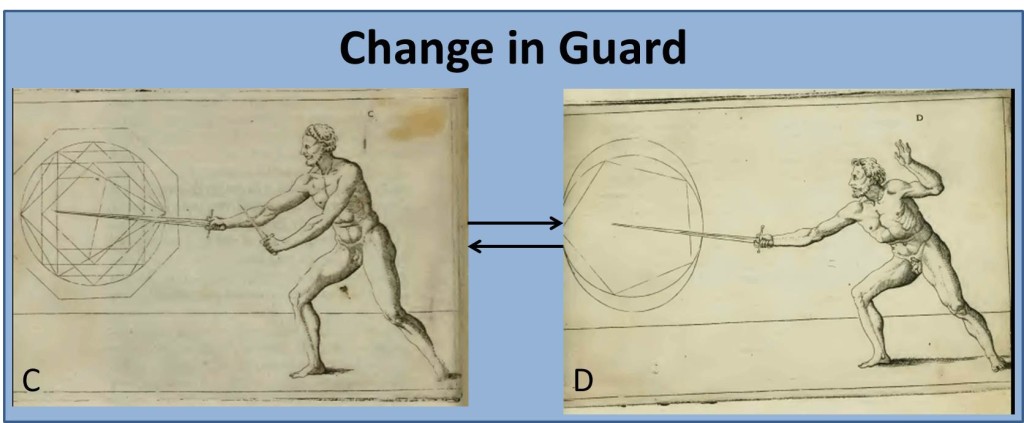
Pingback: Dante di Pietro
Pingback: Jonathan Allen
Pingback: Gawin
Pingback: Wistric
Pingback: Gawin
Pingback: Wistric
Pingback: Jay Rudin
Pingback: Wistric
Pingback: Gawin
Pingback: Walk Like an Agrippan: Part 4 – Stance and Footwork « The Weekly Warfare